The Spiders Blu-ray Movie
HomeThe Spiders Blu-ray Movie 
Kino Lorber | 1919-1920 | 173 min | Not rated | Aug 23, 2016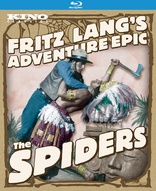
Movie rating
6.8 | / 10 |
Blu-ray rating
| Users | 0.0 | |
| Reviewer | 3.5 | |
| Overall | 3.5 |
Overview
The Spiders (1919-1920)
Sportsman Kay Hoog follows Lio Sha into Chinatown and discloses that his organization seeks a Buddha-headed diamond that will free Asia from tyranny. He is captured, but he escapes and chases The Spiders, as a stowaway. The ship heads to London, with the criminals trying to find the diamond in the mansion of millionaire Terry Landon. They abduct Terry's daughter Ellen demanding the diamond as ransom. But Terry doesn't have it and Hoog discovers that it is in the Malvinas Islands. When he goes there he meets The Spiders.
Starring: Rudolf Lettinger, Ressel Orla, Carl de Vogt, Paul Morgan (I), Lil DagoverDirector: Fritz Lang
| Foreign | Uncertain |
| Western | Uncertain |
| Adventure | Uncertain |
Specifications
Video
Video codec: MPEG-4 AVC
Video resolution: 1080p
Aspect ratio: 1.33:1
Original aspect ratio: 1.33:1
Audio
Music: LPCM 2.0
1536 Kbps (48kHz/16-bit)
Subtitles
English
Discs
Blu-ray Disc
Single disc (1 BD)
Playback
Region A (C untested)
Review
Rating summary
| Movie | 4.0 | |
| Video | 3.0 | |
| Audio | 3.5 | |
| Extras | 0.0 | |
| Overall | 3.5 |
The Spiders Blu-ray Movie Review
Lang's serial adventures.
Reviewed by Dr. Stephen Larson August 22, 2016Kino Lorber's release of Die Spinnen (The Spiders, 1919-20) represents something of a historical landmark as it marks the first high- definition version of Fritz Lang's third and earliest surviving film. Along with The Cabinet of Dr. Caligari (1920), The Spiders ushered in a flourishing period for German silent cinema that produced a slew of successful films by Lang and F.W. Murnau. Originally conceived as a four-part anthology, Lang ended up filming The Spiders as two features: Part One: The Golden Sea and Part Two: The Diamond Ship. Kino has included both on this BD-50 disc.
In the first adventure of Lang's diptych, a man hangs atop the cliff of a Peruvian island and heaves a bottle into the sea. It turns out that the bottle contains an important message informing potential recipients that the Incas harbor large treasures within the ruins of an ancient temple and a goldmine may also exist beneath the sacred lake. Kay Hoog (Carl de Vogt), a wealthy sportsman, uncovers that the messenger is a Harvard University Professor who has been missing in Peru for six years. Rather than compete for the Golden Cup in the San Francisco-to-Japan yacht race, Hoog decides to forgo the trip for more lavish gold and jewels. Also fighting for the treasure is Lio Sha (Ressel Orla), an unscrupulous millionairess and ringleader of an underground criminal network nicknamed "The Spiders." Lang organizes this episode around a series of escapades amidst exotic locales as Hoog battles Sha and her minions in a race for the Incan city. Lang often crosscuts between the planning meetings that go on between Hoog's small entourage and Sha's big syndicate. "The Spiders" are clad in all black and once they finish a crime, they leave an artificial spider at the scene as their calling card. Lang could have scripted a smarter protagonist, especially in the action scenes. For example, Hoog enters in a Mexican tavern alone, knowing full well that he will have to elude Hoog's ragtag of accomplices by himself. Lang's choreography of the escape is far-fetched and unrealistic, as is the Incas' sacrificing of humans in sun-worshiping rituals. Sha tries to blackmail Hoog by wooing him and although he rejects her, he acts unwise by leaving Naela (Lil Dagover), the rescued sun princess, vulnerable to The Spiders. Lang makes up for these flaws in a breathtaking horseback-riding sequence that presages his Hollywood Western, The Return of Frank James (1940).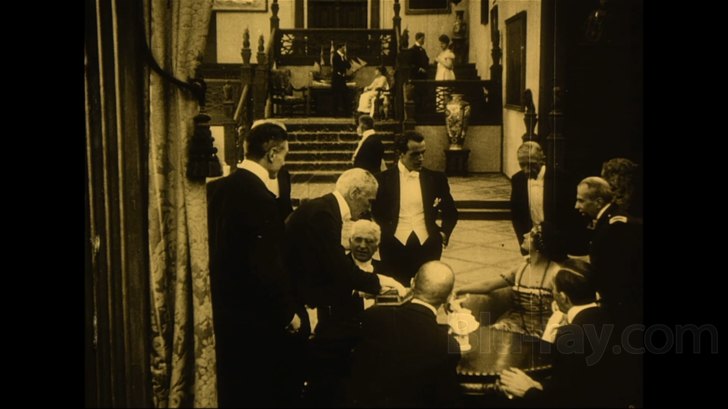
Socialites gather to discuss current affairs at the "Standard Club."
In the second part, Lang shifts the settings across continents traversing the U.S., England, and India where Hoog and Sha battle for a coveted diamond known as "Buddha's Head." Lang packs The Diamond Ship with more thrills and adventures than The Golden Sea but at 104 minutes, the vignettes become too drawn out. However, the film becomes more focused when Hoog gets involved with John Terry (Rudolf Lettinger), the "King of Diamonds" whose pirate ancestors originally uncovered the sought-after Head diamond. Terry learns that his daughter, Ellen (Thea Zander), is being held for a Buddha Head-sized ransom by The Spiders. Hoog tries to devise a plot to unearth the buried treasure before Sha's gang arrives. There is also a subplot involving the evil Dr. Telphas (Georg John), a precursor to Dr. Mabuse. Lang's mise-en-scène demonstrates a masterly eye of precise composition for the then twenty-nine-year-old autuer. In the interior scenes, Lang groups different sections of people in disparate portions within the frame. For instance, in the club and hotel scenes, the viewer can see one phalanx in the foreground and another party in the background. Lang developed a depth of field for staging multi-plane compositions that was uncommon among his peers. The Spiders also saw Lang experiment with mirrors, the lap dissolve, and superimpositions, techniques in which he broadened film grammar and expanded the possibilities of storytelling.
The Spiders Blu-ray Movie, Video Quality 
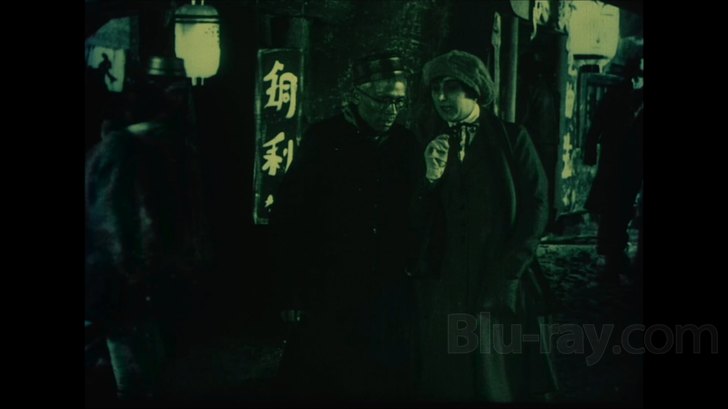
The Spiders appears in an aspect ratio of 1.33:1 courtesy of Kino Classics. The print is a duplicate of the 2012 "Restored Authorized Edition" that Kino put on DVD. The packaging and screen credits contain only a few notes about the restoration. The film was restored by the Friedrich Wilhelm Murnau Foundation in association with the the Royal Film Archive of Belgium. While The Spiders is ninety-six years old, one wonders if Kino could have done more to remove the large amount of damage on this print. It is true that film restorers should always maintain the granularity and compositional makeup of the film's original image. But this video presentation lays bare an assortment of ink blots, smudges, and vertical scratches throughout both episodes. (Thankfully, large tramlines have been eliminated.) There is also flickering and several image stability issues. In the middle of Part Two: The Diamond Ship, warbling is evident. Kino has not applied any foxed or rounded corners but the actual print they worked from sometimes exhibits bottom edges that are curved. During the prologue, the image is very bright but contrast is mostly good for the remainder of the film. Rather unfortunately, the best parts of the presentation are the new intertitles and handwritten letters added by the restoration supervisors. The intertitles are presented in a clear Aerial font with a Griffithian design around the borders containing the Decla-Film logo (Lang's production company at the time).
The Spiders was previously restored by David and Beverly Shepard (of Film Preservation Associates) in 1979 using original German censorship continuity records and Lang's instructions for color tinting. Image Entertainment released the Shepards' restoration on LaserDisc, followed by a DVD in 1999. According to the American Film Institute, David Shepard reconstructed an out-of-sequence 35mm print from the Czech Film Archive. The final restoration of The Spiders was projected at a faster speed and ran 137 minutes. I can't attest to how the tinting and toning matches up against Kino's aesthetic as I haven't seen any of the Image discs. One wonders, however, if Kino also followed Lang's tinting guidelines. It would also be worth investigating other discrepancies in the prints, including location of damage marks. The 2012 restoration does not contain a bad print (it's actually fairly watchable) but Kino could have done a better job of mastering the disc. The video bitrates could be higher and the film could play smoother. Part One and Part Two can only be played individually from the main menu.The Spiders Blu-ray Movie, Audio Quality 
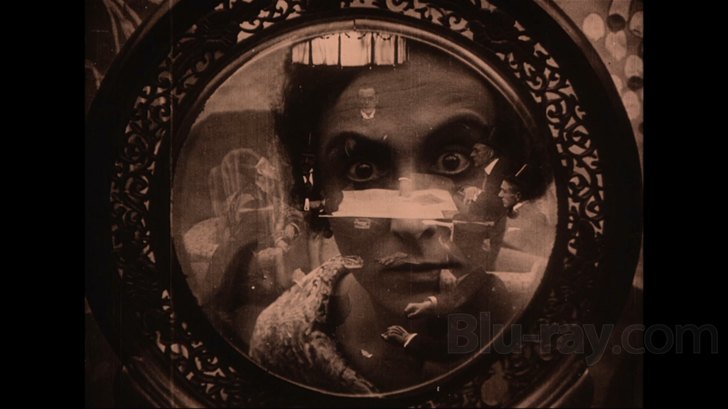
Kino includes an original score composed by Ben Model that is presented in PCM Stereo 2.0 (16-bit). Model's modern score comprises synths, strings, cymbals, and a few other instruments that supply a nice accompaniment to the film. Model's oriental theme for the Chinatown section is one of his most attractive pieces. The instrumentation is clear across all speakers but their is little separation between the front and surround channels. Given that Kino did not include any extras, it would have been ideal to give Model's score a lossless 5.1 mix akin to the dynamic presentation Carl Davis's music received courtesy of Cohen and Eureka in their Blu-ray releases of Intolerance (1916). Model's pieces don't require a large orchestral ensemble like Davis's composition do but Kino's audio track could have benefited from an extra boost.
The Image discs featured an original organ score for The Spiders performed by longtime silent film accompanist Gaylord Carter. Perhaps due to copyright reasons, this score is not included on Kino's disc as an alternate track.The Spiders Blu-ray Movie, Special Features and Extras 
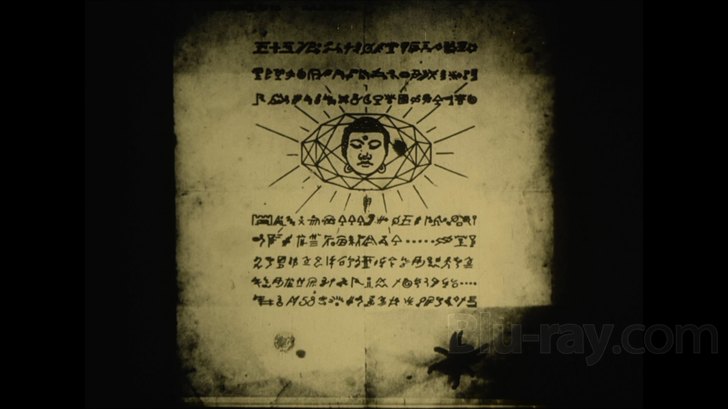
Disappointingly, Kino has dropped the forty or so images of movie lobby cards and programs from the archives of the Deutsch Kinematek that it included on the DVD.
The Spiders Blu-ray Movie, Overall Score and Recommendation 
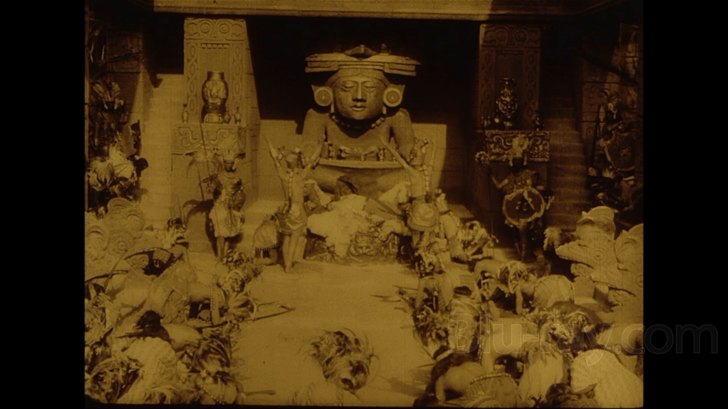
The Spiders is a very ambitious action/adventure epic undertaken by Fritz Lang at the beginning of his career. Kino's video transfer is adequate but leaves a lot to be desired. Ben Model's original music synchs well with Lang's images but one yearns for a more spatial rendering of the sound track. Kino missed out in licensing and acquiring the Shepards' restoration, which would have been a perfect supplement on a second disc. If and when Eureka's Masters of Cinema series gets around to working on The Spiders, the restoration master will likely be similar to Kino's but probably with a superior encode. Despite these drawbacks, the movie is definitely recommended to cinephiles who appreciate an early offering from the Golden Age of silent cinema.
Similar titles
Similar titles you might also like

The Wandering Shadow
1920

Four Around the Woman
1921

Harakiri
1919

The Plague of Florence
Die Pest in Florenz
1919

Destiny
Der müde Tod
1921

Spies
Spione
1928

Woman in the Moon
Frau im Mond
1929

Die Nibelungen: Kriemhild's Revenge
Die Nibelungen: Kriemhilds Rache
1924

El Topo
Remastered
1970

4 Dollars of Revenge
Cuatro dólares de venganza
1966

The Last Gun
Jim il primo
1964

The Hidden Fortress
隠し砦の三悪人 / Kakushi-toride no san-akunin
1958

Face to Face
Faccia a faccia
1967

My Name Is Pecos
Due once di piombo
1966

If You Meet Sartana... Pray for Your Death
Se incontri Sartana prega per la tua morte / Gunfighters Die Harder
1968

The Return of Ringo
Blood at Sundown / Il ritorno di Ringo
1965

The Gardener
2012

The Silence
1998

El Puro
The Reward's Yours... The Man's Mine
1969

I'll Be Alone After Midnight
Je Serai Seule Après Minuit
1931